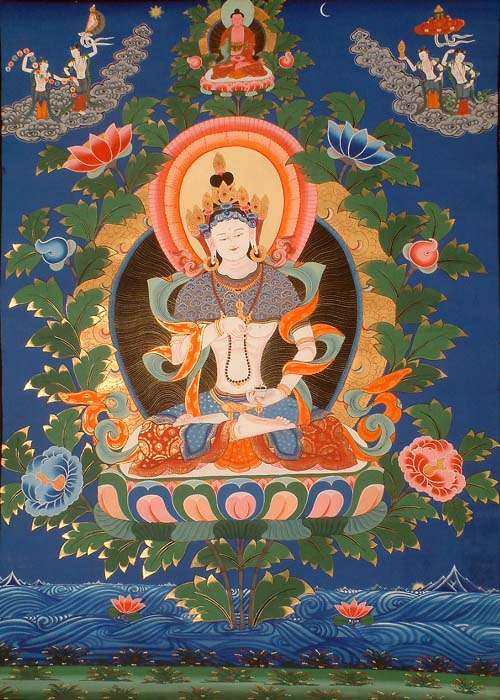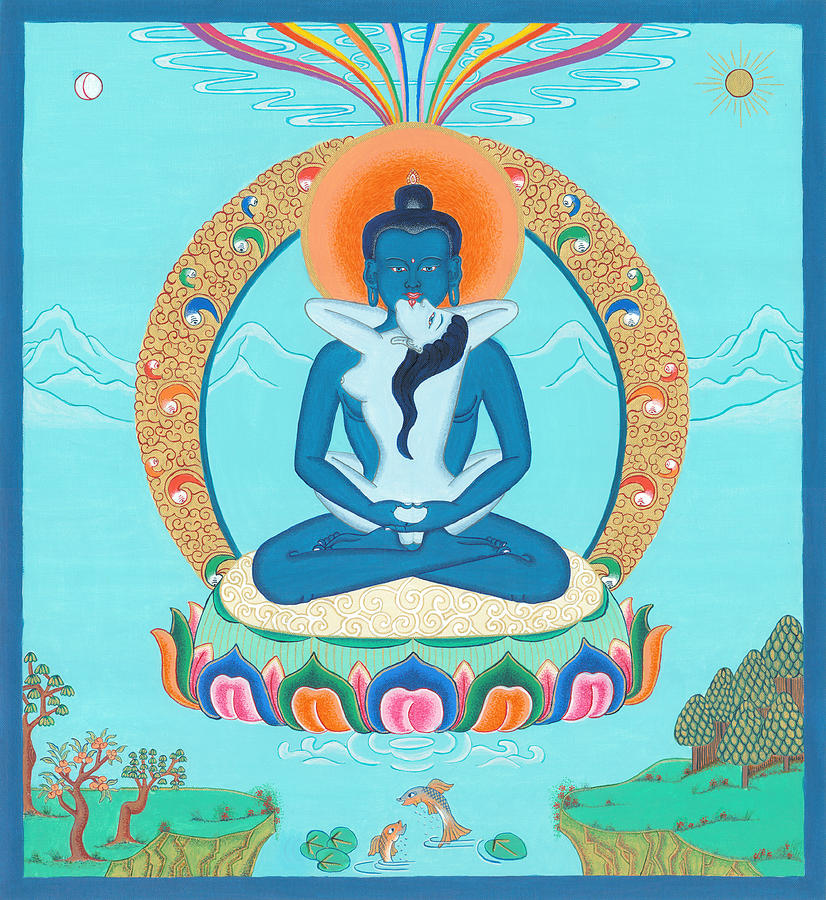Adibuddha
A Adibuddha is a transcendent Buddha regarded as the embodiment of absolute truth (see also Dharma Philosophical meaning). Adibuddha means primordial Buddha and he belongs to the Dharmakaya, the level of duality free, simultaneously transcendent and immanent absolute truth and reality, which is the essence of all the Buddhas.
The idea of Adibuddha is in 6/7 Have originated century and was taken from the Tantrayana in the Mahayana Buddhism. Most famous are the " big five transcendent Buddhas" (also: Dhyani Buddhas; Tib. rgyal po sku lnga ) Vairocana, Aksobhya, Amitabha, Ratnasambhava and Amogasiddhi. The typology of the five Buddha families ( Buddhakula ) also forms the basic structure of the visualized in the Sadhana deities.
- 6.1 Samantabhadra
- 6.2 Vajradhara
- 6.3 Vajradharma
Vairocana
The most famous Adibuddha has Vairocana ( Sanskrit: वैरोचन, phonetically - inspired Chinese毗卢遮那 佛, Pinyin Piluzhenafo, Japanese Birushana - butsu, kor Birokana or semantically - modeled大 日 如 来/大 日 如 来, Dari Rulai, jap. . Dainichi nyorai, Tib: རྣམ་པར་སྣང་མཛད་ rNam -par snang mdzad, Mongolian: Teyin böged geyigülügci viet,: Dai Nhật Nhu Lai, " the same sun " ), which dominates the center of the highest mandala.. He radiates through the universe and is considered omniscient ( Sarvavid ). It combines the wisdom of all the Buddhas in itself and is also considered a cosmic Buddha who caused it all. Vairocana is the Lord of Buddha family and converts, if you meditate on the Buddha of Buddha - family, ignorance ( avidya ) in the nature of all Buddhas, the wisdom of the final realization has to offer. He is sometimes depicted with four faces, with which he looks into all parts of the world. Its symbol is a sun disc and its Mudra is the area enclosed by the left hand, right index finger as a symbol of the union of opposites. In the Chinese Hua -yen and Japanese Shingon Vairocana plays a major role and is venerated. He is in the mandala surrounded by one hundred sixty-three phenomena of the Pantheon - to them, count the Buddhas of the four directions, Akshobya, Amitabha, Ratnasambhava and Amoghasiddhi, the Tathagatas who belong to the sambhogakaya level.
Aksobhya
Akshobhya (: mi bskyod pa; " The Unyielding " ) is the head of the Buddhas of Vajrafamilie. The Buddhas of Vajrafamilie are the Störgefühl associated anger and convert it if you meditate on the forms of this family into mirror-like wisdom. He is assigned to the East. His pure land is called Abhirati.
Vajrasattva
Often worshiped instead of Aksobhya as Adibuddha and highest transcendent Buddha of Vajrafamilie; : In Nepal and northern India of Buddha Vajrasattva is sambhogakaya ( " Diamond Mind " rdo rje sems dpa ' ( Dorje Sempa ) Tibetan). The sambhogakaya body is a kind of light body, or rather, subtle bodies, take the Buddha to appear realized yogis and Bodhisattvas. He can sentient beings from ordinary no or limited are perceived.
Vajrasattva means " having the Vajra of the essence ". He wears the jewelry of sambhogakaya and is therefore depicted with a five-pointed headdress, necklace and bracelets. He holds in his right hand the vajra and in his left hand the bell ( ghanta ) as a symbolic representation of the union of opposites, as the Vajra is male and the compassion symbolized, while the bell is female and wisdom personified. Vajrasattva is regarded as the Buddha, who embodies the purity of all the Buddhas of karmic veils. The practice of Vajrasattva is therefore one of the most important tantric cleaning practices. Vajrasattva is of great importance in the transmission of Dzogchen, the Great Perfection, which are passed on, especially in the Nyingma school of Tibetan Buddhism as the essence of the Buddha's teachings.
Amitabha
Main article: Amitabha
The "Buddha of Infinite Light " is Lord of the Buddhas of the Lotus family and is enthroned in the Pure Land of Sukhavati. The Buddha of the lotus family are the Störgefühl associated with greed and convert it into the Störgefühl the underlying wisdom aspect of discriminating wisdom. He is assigned to the West. Important sambhogakaya emanations of Amitabha is the Bodhisattva Avalokitesvara and the Buddha of Long Life Amitayus.
Padmasambhava is considered to be an incarnation of Amitabha, Buddha Shakyamuni also.
Ratnasambhava
Ratnasambhava ( Tib. rin chen ' byung gnas ) is Lord of the Buddhas of the Ratna ( gem ) family. The Buddhas of the Ratna family pride to walk in balancing wisdom. He is assigned to the southern part of the world.
Amoghasiddhi
Amoghasiddhi ( Tib. don yod grub pa), the Buddha of the northern region of the world is Lord of the Buddhas of the Karma family and transforms envy / jealousy in all -accomplishing wisdom. This is also the meaning of his name: " The wisdom completed." In popular belief, he is regarded as a success bringer. The symbol of this family is the Doppelvajra.
Special Urbuddhas of Vajrayana
Samantabhadra
→ Main article: Samantabhadra
Another essentially worshiped only in the Vajrayana form of Adibuddha is Samantabhadra (Tib.: Kuntuzangpo ), " the All- Good " or " round the Blessed " or " the Lord of Truth." He appears naked, with no attributes and symbolizes the primordial Erleuchtetheit of the mind itself, as well as the practice and meditation of all Buddhas. According to the tradition of Tibetan Buddhism, Samantabhadra has never occurred in samsara. Samantabhadra is closely associated with the teachings of Dzogchen (the " Great Perfection " ) and is therefore particularly revered in the Nyingma, but also the Bon school. The impulse to transmit the teachings of Dzogchen was submitted by the Dharmakaya Buddha Samantabhadra to the sambhogakaya form (enlightened energy level ) Vajrasattva (Tib. Dorje Sempa ). This transferred to the Dzogchen nirmanakaya ( manifestation level) and the first human holders of these doctrines Garab Dorje. The hands of Samantabhadra are merged into meditation gesture. In Tantric Buddhism, Samantabhadra is (dark blue ) is often represented with Samantabhadri, his feminine side in union. They symbolize awareness - emptiness, the pure absolute, ever-present and unfettered nature.
Vajradhara
Vajradhara ( Tib. rdo rje ' chang ( Dorje Chang); "Diamond Holder" ) is another transcendent Buddha, the sambhogakaya form of Samantabhadra and crosses in this form bell and vajra, which at the level of sambhogakaya the union of practical means and symbolizes wisdom. His female counterpart is Prajnaparamita, an embodiment of highest wisdom. Vajradhara has in the Tibetan schools Sakya, Kagyu, Gelug and that relate to the transmission of the Mahamudra ( " Great Seal " ) focus, of central importance, is recognized as the point of transfer.
Vajradharma
Vajradharma (Tibetan: rdo rje chos ( Dorje Cho ) ) also applies in the Kagyu school as Adibuddha. He is depicted with two crossed in front of the heart vajras. Vajradharma Buddha is regarded as the line of Vajrayogini.









